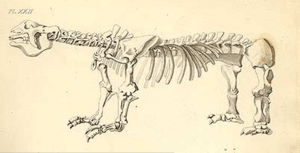James Parkinson facts for kids
Quick facts for kids
James Parkinson
|
|
|---|---|
| Born | 11 April 1755 Shoreditch, London, England
|
| Died | 21 December 1824 (aged 69) Shoreditch, London, England
|
| Resting place | St Leonard's Church, Shoreditch |
| Alma mater | The London Hospital |
| Occupation |
|
| Known for | First description of Parkinson's disease |
| Spouse(s) |
Mary Dale
(m. 1783) |
| Children | 8 |
| Signature | |
 |
|
James Parkinson (born April 11, 1755 – died December 21, 1824) was an English doctor, geologist, paleontologist, and even a political activist. He is most famous for his book from 1817 called An Essay on the Shaking Palsy. In this book, he was the first person to describe a health condition that would later be named Parkinson's disease after him.
Contents
Early Life and Family
James Parkinson was born in Shoreditch, a part of London, England. His father, John Parkinson, was a surgeon and ran a pharmacy in Hoxton Square in London. In 1784, James Parkinson became a certified surgeon, just like his father.
On May 21, 1783, he married Mary Dale. They had six children together. Soon after getting married, James took over his father's medical practice in Hoxton Square.
Medical Discoveries
Between 1799 and 1807, James Parkinson wrote several medical books. One of these was about gout, a type of arthritis, published in 1805. He also wrote some of the first descriptions in English about a condition called peritonitis, which is an infection in the belly.
Parkinson was the first to carefully describe six people who showed signs of the disease now named after him. What's interesting is that he didn't actually examine these patients in his office. Instead, he observed them during his daily walks around London! More than 60 years later, a doctor named Jean-Martin Charcot officially gave the condition the name "Parkinson's disease".
Parkinson also cared a lot about making people healthier and happier. He strongly supported laws to protect people with mental illnesses, as well as their doctors and families.
In 1812, Parkinson helped his son with a very important medical case. They described the first known case of appendicitis in English medical history. They also showed for the first time that a burst appendix could cause death.
Exploring Science and Fossils

Over time, James Parkinson became more interested in nature than just medicine. He especially loved the new fields of geology (the study of Earth's rocks and history) and paleontology (the study of fossils). He started collecting fossils and making drawings of them in the late 1700s.
He would take his children and friends on trips to find and study fossil plants and animals. Parkinson found it hard to learn about fossils because there weren't many books on the topic. So, he decided to write his own book to help others learn.
In 1804, the first part of his big work, Organic Remains of the Former World, was published. Another famous geologist, Gideon Mantell, praised it as "the first attempt to give a familiar and scientific account of fossils." The second part came out in 1808, and the third in 1811. Parkinson drew all the pictures for each book, sometimes even in color!
Later Life and Legacy
James Parkinson passed away on December 21, 1824, after having a stroke that affected his speech. He left his homes to his sons and wife, and his pharmacy shop to his son John. His collection of fossils was given to his wife, and much of it was sold a few years later. He was buried at St. Leonard's Church in Shoreditch.
Today, Parkinson is remembered in several ways. There's a stone tablet inside St. Leonard's Church where he used to worship. A blue plaque at 1 Hoxton Square shows where his home and office used to be. Many fossils have also been named after him!
It's interesting to know that no real picture of James Parkinson exists. Sometimes, a photo is shown that people think is him, but it's actually a dentist with the same name. James Parkinson died before cameras were invented!
Every year, World Parkinson's Day is celebrated on his birthday, April 11. Besides the disease, several fossil creatures are named after him. These include the ammonite Parkinsonia parkinsoni, the sea lily Apiocrinus parkinsoni, the snail Rostellaria parkinsoni, and the tree Nipa parkinsoni.
Images for kids
-
Fossilized turtle Puppigerus found in the London Clay on the Isle of Sheppey and named for Parkinson, collection Teylers Museum
See also
 In Spanish: James Parkinson para niños
In Spanish: James Parkinson para niños




